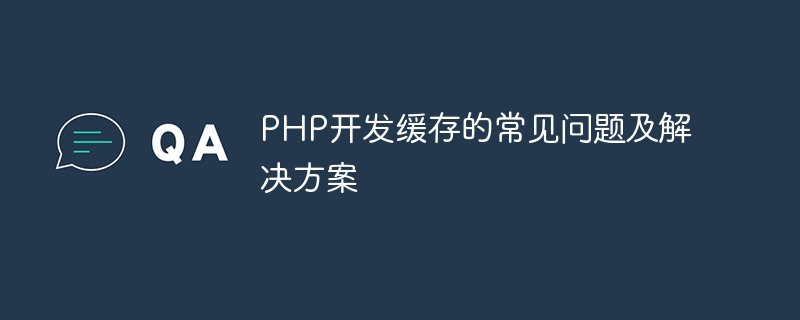Home >Backend Development >PHP Tutorial >Common problems and solutions for PHP development caching
Common problems and solutions for PHP development caching
- 王林Original
- 2023-11-07 16:45:27653browse

Common problems and solutions for caching in PHP development
In the PHP development process, in order to improve website performance and user experience, using caching is a common optimization method. However, you will also encounter various problems when using cache. This article will introduce common caching problems in PHP development and provide corresponding solutions and specific code examples.
1. Low cache hit rate
- Problem description: The cache hit rate is low, most requests have to regenerate the cache, and the cache cannot be fully utilized to improve performance.
-
Solution: There are many ways to improve the cache hit rate. The following are some commonly used methods:
- Check the cache hit before reading the cache. If the cache Does not exist or has expired, please regenerate the cache.
- Set a reasonable cache time to ensure that the cache can be hit multiple times within the validity period.
- Use appropriate caching alternatives, such as using a CDN to cache static resources.
2. Cache consistency problem
- Problem description: After update operations (such as adding, modifying, deleting), the cache is not updated in time , causing the cache to be inconsistent with the database.
-
Solution: In order to avoid cache consistency problems, you can take the following measures:
- Clear or update the relevant cache in a timely manner when performing an update operation.
- Use the "delayed update" strategy, that is, do not delete or update the cache immediately, but mark the cache as expired and provide a background task to perform delayed update of the cache.
- Using mechanisms such as cache version numbers or tags, the corresponding cache can be identified and updated when the cache is updated.
3. Cache avalanche problem
- Problem description: When a large amount of data in the cache expires at the same time, or the server is restarted, a large number of requests are directly accessed. database, causing excessive pressure on the database and reduced performance.
-
Solution:
- Set different cache expiration times to avoid cache invalidation at the same time.
- Use a distributed cache cluster to disperse the cache to different nodes to improve fault tolerance.
- Set up a reasonable cache preheating mechanism to generate cache of popular data in advance.
4. Cache penetration problem
- Problem description: Cache penetration refers to malicious requests for a large amount of non-existent cached data, resulting in every All requests must access the database, causing excessive pressure on the database.
-
Solution:
- Perform parameter verification at the code level and filter out invalid requests.
- Store non-existing cached data in the cache, and set a shorter cache time to avoid frequent requests.
- Use data structures such as Bloom filters to quickly determine whether the requested cached data exists.
5. Cache breakdown problem
- Problem description: When a popular cache expires, a large number of requests access the database at the same time, causing database pressure is too big.
-
Solution:
- Use a mutex lock mechanism to lock when generating a hot cache to avoid concurrent requests from accessing the database at the same time.
- Set a reasonable cache expiration time to avoid a large number of concurrent requests when the cache expires.
- Use asynchronous update cache to improve concurrent processing capabilities.
In summary, for common caching problems in PHP development, we can adopt corresponding solutions to optimize performance and user experience. Not only do you need to understand the basic concepts and principles of caching, but you also need to select appropriate caching strategies and solutions based on specific business scenarios and needs, and conduct detailed code implementation and tuning.
(The above are only examples. Specific problems and solutions may vary depending on actual application scenarios and require comprehensive consideration of other factors)
The above is the detailed content of Common problems and solutions for PHP development caching. For more information, please follow other related articles on the PHP Chinese website!
Related articles
See more- [php cache library] 10 php cache libraries download
- ThinkPHP template engine implementation and common problems
- Summary of common problems in PHP development
- CSS FAQ: How to draw polygons (triangles ~ hexagons)
- A summary of frequently asked questions about PHP multi-process development interviews (with answers)

